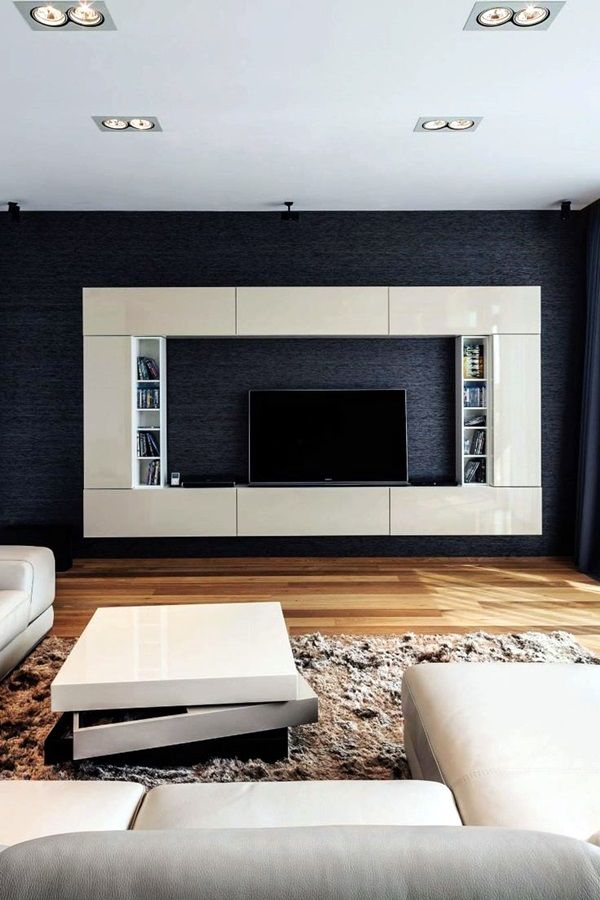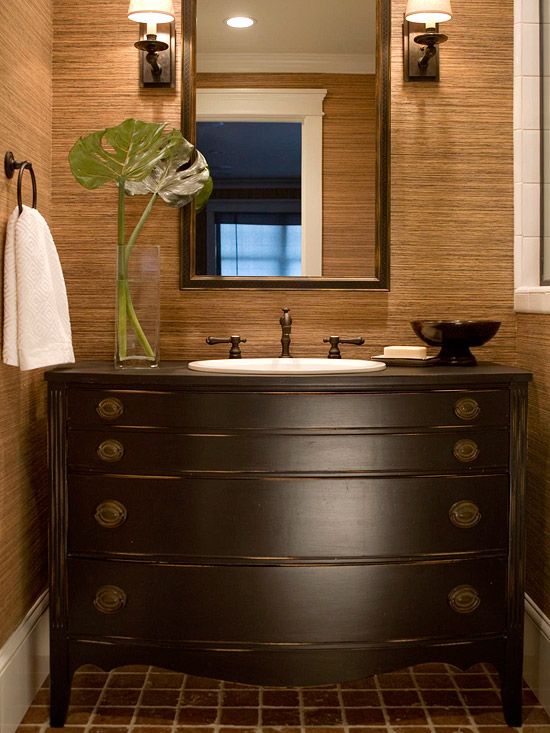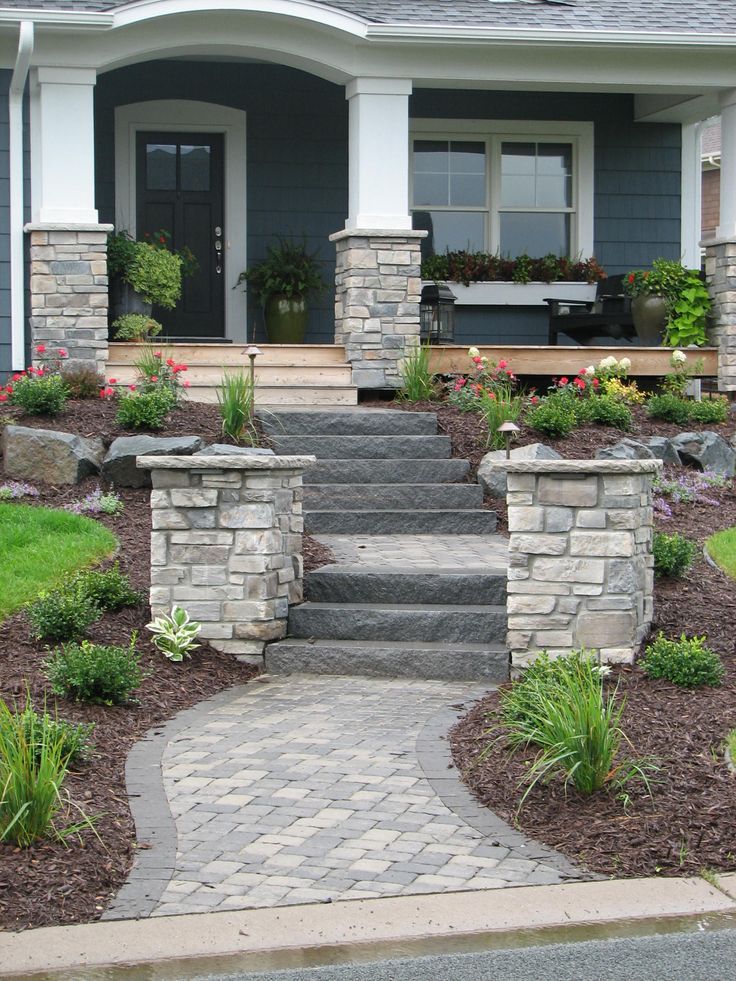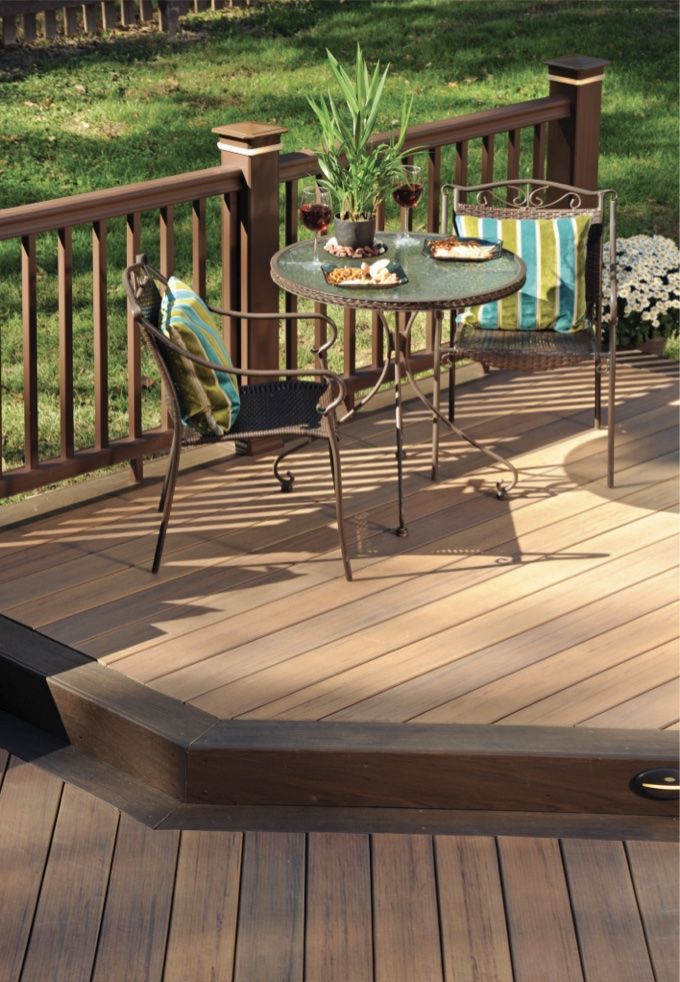Tv in middle of room interior design
Where to Put the TV When the Wall Won't Work
It can be a challenge to find the right spot for the television in today's open-plan homes, lofts, and rooms with floor-to-ceiling windows. In these cases, putting the TV against a wall can mean your seating will have its back to the rest of the room. Or it can mean you have big problems deciding whether to situate furniture to face the TV or face the view.
What if you could just get away from the wall and place your TV out in the middle of the room? Well you can! There are just a few essential elements to doing this successfully and having it look like it was meant to be.
Elad Gonen
Here are the three essential elements to float your TV away from the wall.
1. Hide the back of the TV with cabinetry.
2. Place all your components inside the cabinet.
3. Use a power strip inside the cabinet so all cables and cords are contained inside the cabinet. You will then only need to deal with a single power cord emerging from the cabinet.
The cabinet in this photo fits the bill. Beautiful on all sides and plenty of room for components, cables, a power strip and cords. By keeping it no taller than is necessary it defines the TV and dining areas without dividing the room.
Tip: Floor-mounted electrical outlets are your friend. If you are installing a new outlet, place it right under the cabinet, and allow space under the cabinet for the plugs because they will stick up from the outlet a couple inches. Create an access panel in the bottom of the cabinet so you can reach the plug.
ome.co.il
In a living room like this, with floor-to-ceiling windows all the way around, walls for the TV are hard to come by. They’ve built a box to house the TV which matches the cabinet below. They are close enough to a wall to possibly have a wall outlet to plug into, but with all of those windows, they may have used a floor plug.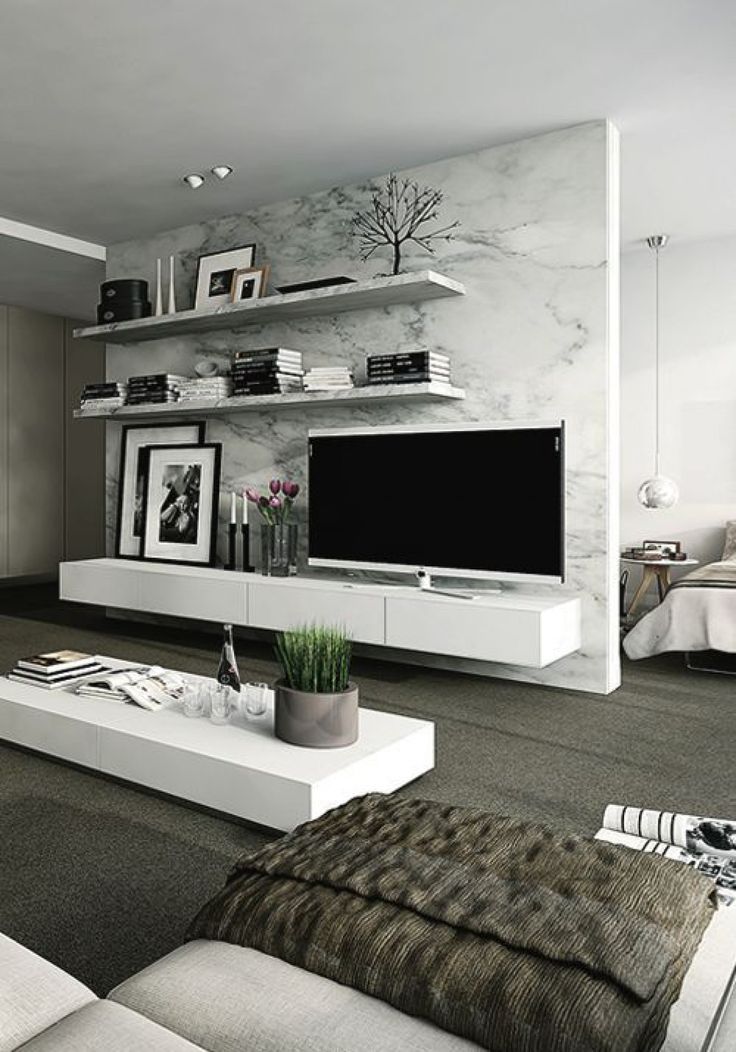
Browse thousands of entertainment centers and TV stands
ome.co.il
Hiding the back of the TV makes seeing it from outside no worse than seeing the backs of chairs or other furniture. Again, it is essential that your cabinet has room to house the components and their cables.
Tip: If you don't want to see all of the extra components — dvd player, cable boxes, and so on — keep the doors of the cabinet opaque. You can install a device called an "IR repeater" (pronounced "eye-are-repeater") under the TV screen for each item you need to run with a remote. The IR repeater is very tiny so you can mount a few of them under the TV screen to run multiple components.
Susan Diana Harris Interior Design
A TV holder like the one in this photo hides the back of the TV and is nice looking from behind. It will not hide all of the cables, so I would recommend this type when you have just a minimum number of components.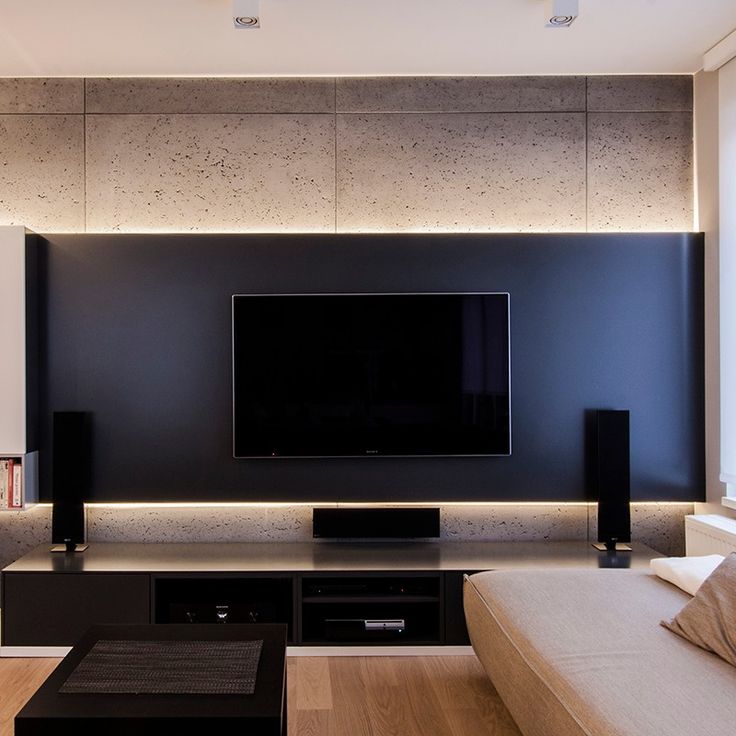 I would be tempted to place a box on the base of this that housed the components and their cables with a power strip inside. It is ideal to have no more than one power cord emerging from your cabinet.
I would be tempted to place a box on the base of this that housed the components and their cables with a power strip inside. It is ideal to have no more than one power cord emerging from your cabinet.
Tip: If you cannot install a floor-mounted electrical outlet, then use the best cable cover you can get to hide the cord and make it lie flat on the floor as it runs to your wall outlet. Remember you are using a power strip inside your cabinet so you only have to hide one cord. I’ll say more about this later.
Sam Crawford Architects
I realize this TV is not in the middle of a room, but it sure could be. This TV cabinet has a motorized lift inside so you can raise the TV up to watch, then ...
Sam Crawford Architects
… lower it so the whole thing is hidden the rest of the time. I don’t know why I didn’t find scads of photos of these on Houzz, because I think they are the best thing since sliced bread! You can buy the motorized lifts separately and install them in any cabinet with enough space.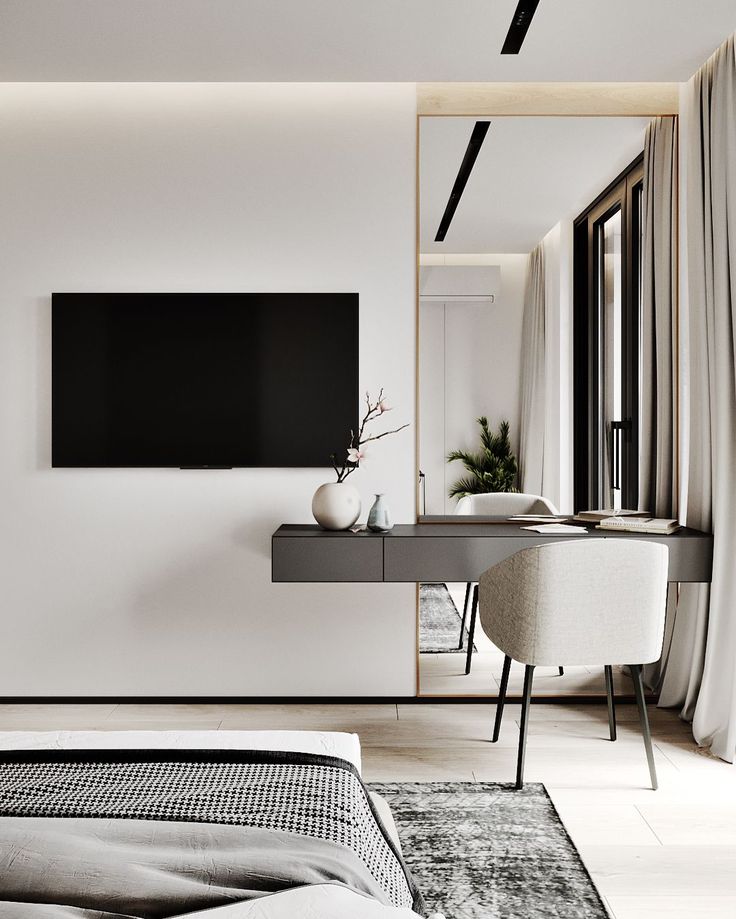
Hire a pro to install your new TV
Since the TV needs to descend into the cabinet, and you’ll also need some room for the motor, I would use a longer cabinet so that the components can be placed to either side of the TV instead of below it.
Hoedemaker Pfeiffer
People have been using motorized lifts in TV cabinets at the foot of a bed for years now. Look closely, and you can see the panel on the top of the cabinet where the TV comes up. The only difference in floating the cabinet in the main living area is that you can’t hide the cord under a bed.
Hiding the cord cover: If you can’t find a cord cover that matches your floor, here’s an idea. Self-adhesive contact paper comes in woodgrain and a multitude of colors. Buy contact paper that matches your floor as closely as possible and use it to wrap the cable cover. If you have carpeting, the cable covers are made of fabric with Velcro strips running the length of both sides.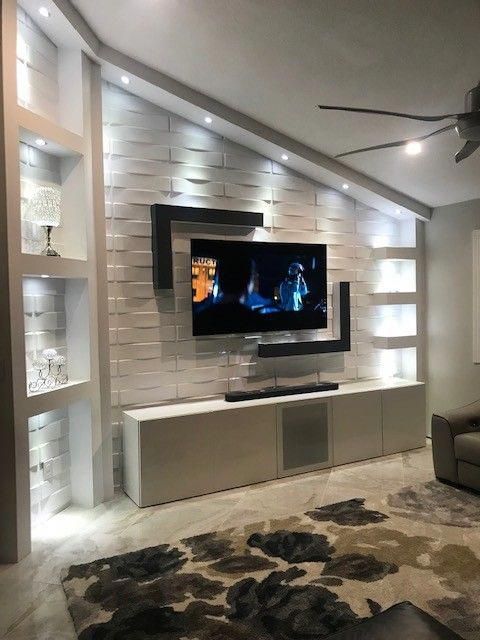 Make one out of wool or heavy felt to match your carpet as closely as possible.
Make one out of wool or heavy felt to match your carpet as closely as possible.
I know some people don’t like to see cord covers, but ask yourself what bothers you more: a cord cover, sitting with your back to the room, or facing the wall instead of the view?
PreviousNextItem 3 of 7
Where to Put the Television in Any Room
There is a subtle science to interior design – especially proper TV placement. If you simply throw your television in a corner, you will likely be stuck craning your neck, disturbing your decorations, turning up the volume too high or any other combination of inconveniences. While most people get along just fine not putting too much thought into where their TV lands, there are still a few tips you should keep in mind to get the most out of your living and entertaining spaces.
Determining the Right TV Height and Distance
When it comes to proper TV placement, height and distance are the most important elements to consider.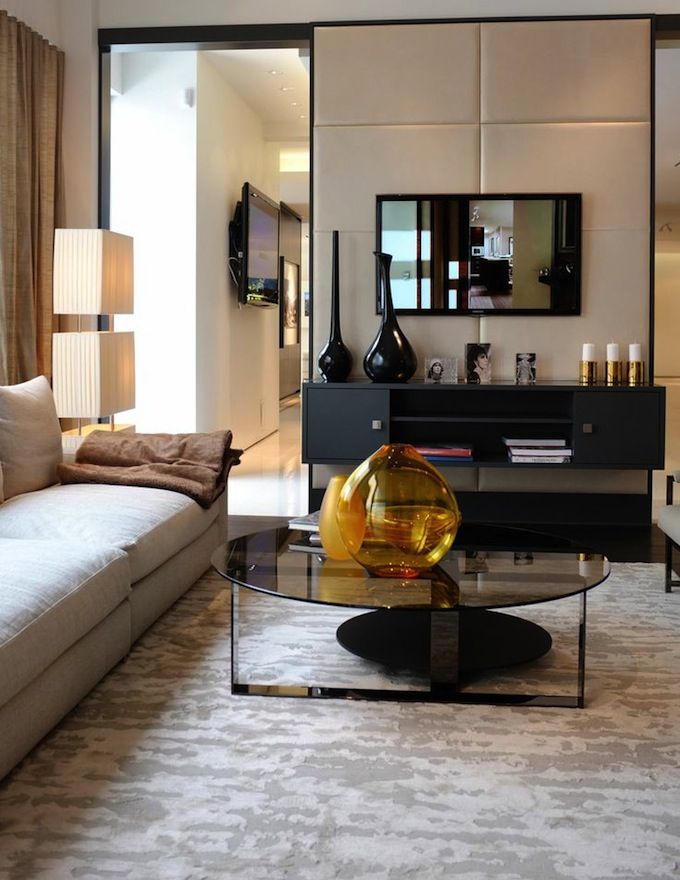 It is easy to become preoccupied by fitting every piece of furniture into a room layout or mapping out your dream home theater without considering the personal comfort of the arrangement. There’s no reason to fret — these reminders will help you avoid such a slip-up.
It is easy to become preoccupied by fitting every piece of furniture into a room layout or mapping out your dream home theater without considering the personal comfort of the arrangement. There’s no reason to fret — these reminders will help you avoid such a slip-up.
First, the television height should be at eye level for someone who is sitting down, not standing up. If the TV has to be higher up on the wall, the screen should be angled down so it’s still at eye level. Otherwise, a mounting low on the wall or on a short piece of furniture is preferable, so when you’re seated your head will line up with the middle of the screen. It’s much more comfortable to look straight ahead instead of up at the screen.
One of the most common interior design mistakes is buying a piece that is out of scale with a room. This goes for your television as well. It’s one thing for a TV to be the focal point of a living space, but it’s another entirely if it dominates the room at the expense of the rest of your décor.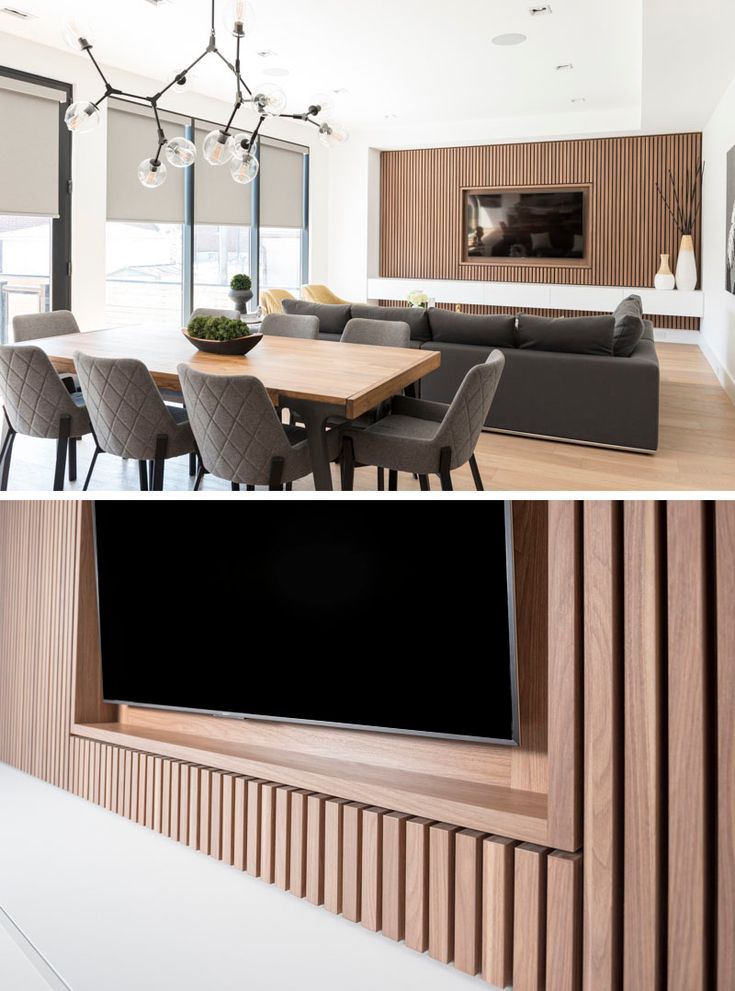 Try not to cram a big TV into a small room, not just because it will dwarf your decorations and furnishings, but also because it will hurt your eyes.
Try not to cram a big TV into a small room, not just because it will dwarf your decorations and furnishings, but also because it will hurt your eyes.
The viewing distance you should strive for depends on the size of your TV, if it’s high definition or not and the layout of the room. Carefully calculate where you place your television or entertainment cabinet. Station it an appropriate distance from where you will be viewing the screen so watching TV will not lead to eyestrain.
For example, with a 26-inch screen you only have to be 3 to 5 feet away. However, a 40-inch screen requires 5 to 9 feet of space for ideal viewership. Then when you upgrade to a TV that’s 65 inches, you should be 8 to 14 feet away from it.
If Your Living Room Has Several Windows
A living room with multiple windows is a beautiful thing to behold, but it can also make TV placement a bit difficult. If you’re struggling with where to put the TV in a living room with lots of windows, the simplest solution is to install window treatments.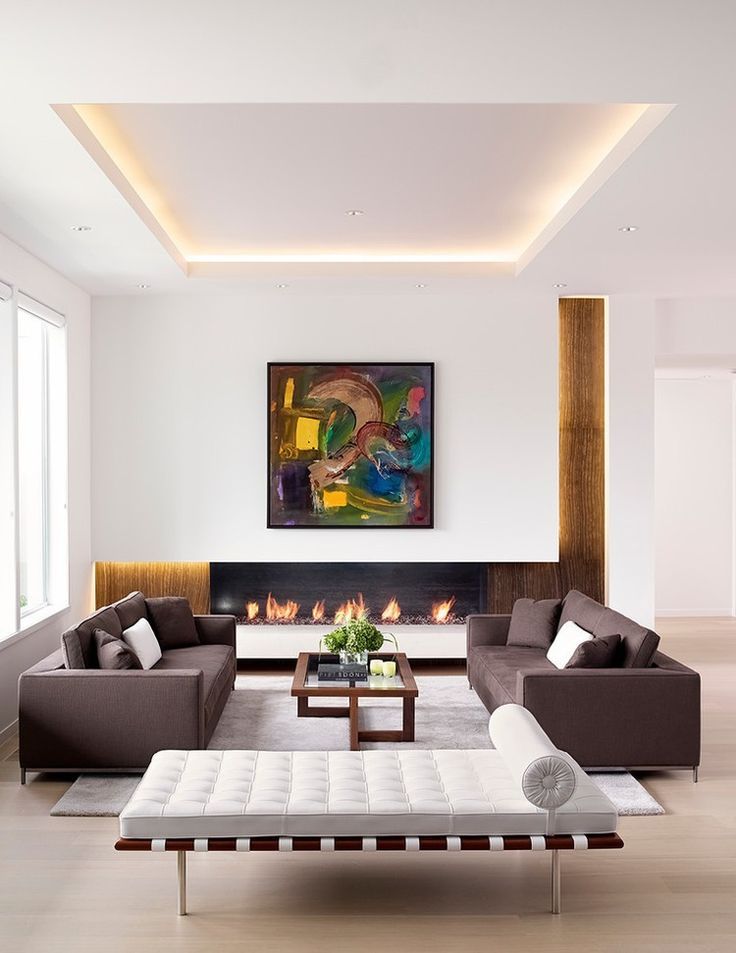 Opaque drapes can be very helpful, and draperies with liners will definitely remove the glare on a TV in a sunny room. Roman shades or woven wood shades will do the trick as well. The window treatments you choose will depend on the design scheme of the room.
Opaque drapes can be very helpful, and draperies with liners will definitely remove the glare on a TV in a sunny room. Roman shades or woven wood shades will do the trick as well. The window treatments you choose will depend on the design scheme of the room.
For those who want to know if they can put a TV in front of a window, generally it is best to avoid it. Try not to place your TV in front of or opposite a window, especially one that faces west. You want to cut down on the level of glare and the amount of light shining on the screen as much as possible. Whatever room you’re designing, it’s important to note the direction natural light will be coming in from when deciding where to put the TV.
How to Handle a Room with a Fireplace
Knowing where to put the TV in a living room with a fireplace can be particularly puzzling. Is it OK to mount it above the fireplace? Would it look weird off to one side? Should you put the television on the opposite wall just to be safe, or would this make the layout of the room too strange?
If your fireplace isn’t very tall, it might work to position the television over it.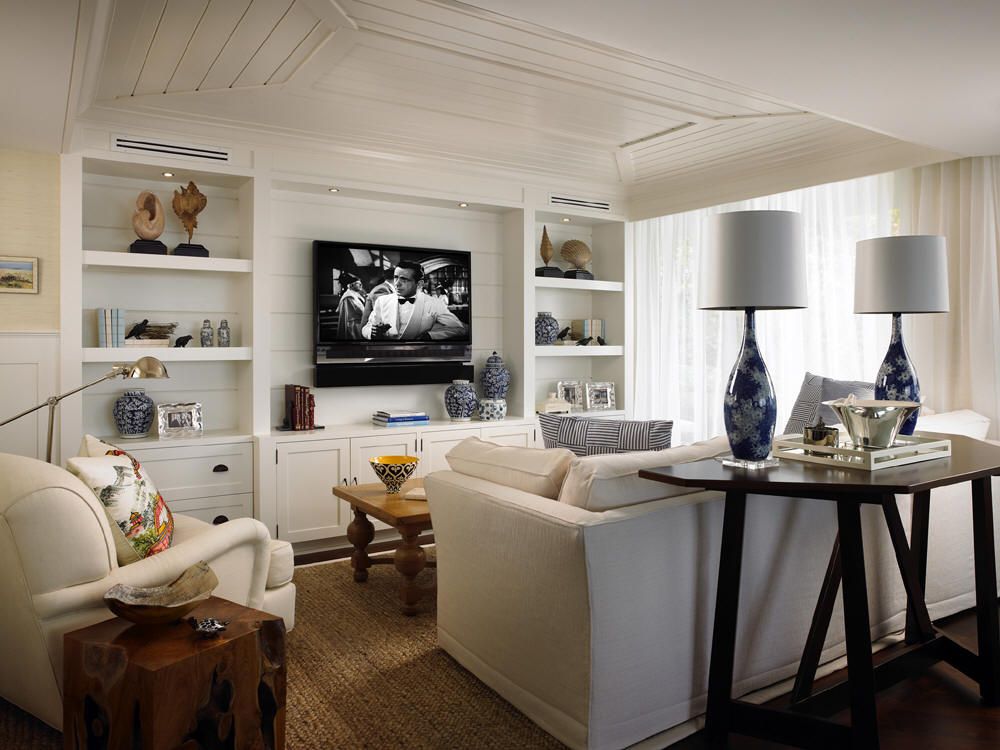 This will allow the fireplace to remain the focal point of the room and heightens the coziness of the living space. Of course, it helps if you’re able to angle the screen down a bit for easier viewing. For anyone building their own house or remodeling a room to include a fireplace, if you plan to have a TV above it, you should install a low, rectangular fireplace. This will enable the most ideal TV placement.
This will allow the fireplace to remain the focal point of the room and heightens the coziness of the living space. Of course, it helps if you’re able to angle the screen down a bit for easier viewing. For anyone building their own house or remodeling a room to include a fireplace, if you plan to have a TV above it, you should install a low, rectangular fireplace. This will enable the most ideal TV placement.
However, unless you really have your heart set on having a television above your fireplace, you should avoid placing it there if at all possible. Looking up at a TV over the fireplace will hurt your neck, and the screen will probably be at an off angle. Instead, you should consider putting the TV next to the fireplace. This may sound a little weird, but this positioning will guarantee the TV is at the right level, and you’ll be able to feel the warmth of the fireplace while you’re curled up watching a movie.
If you do decide on a TV to one side of the fireplace, it should be angled toward the viewers.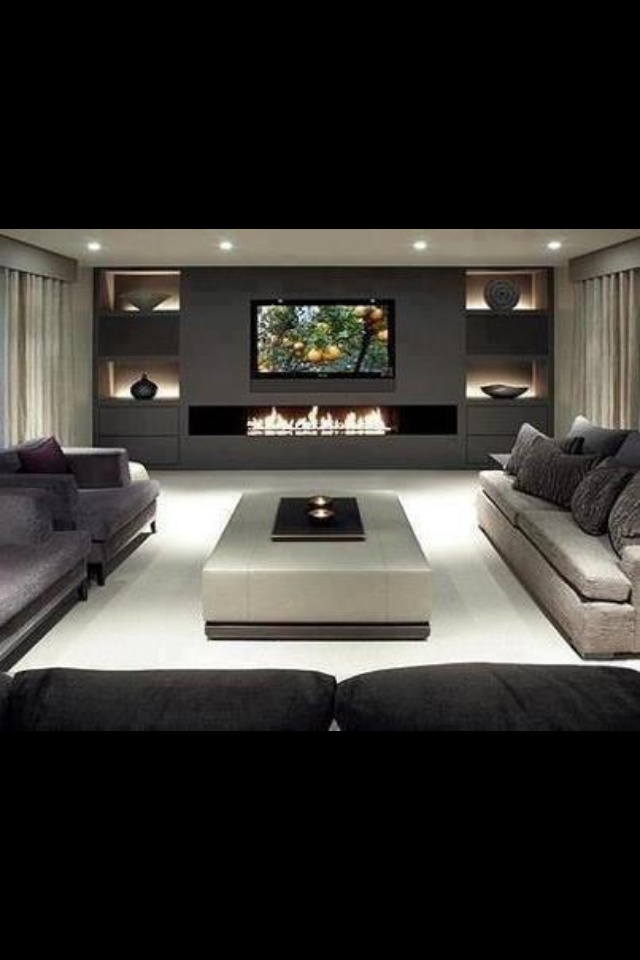
It is not advisable to put your television on the opposite side of the room as your fireplace. This will create competing focal points and make it exceedingly challenging to arrange your furniture in a way that doesn’t ignore either of them. The only remedy would be investing in seating that swivels around or is lightweight enough to be turned when you want to change your focus.
Positioning the TV in Your Bedroom
Popular opinion can be pretty divided on the idea of a television in the bedroom. Some people say it negatively affects your sleep cycle, while others don’t see the harm. After all, it gives you the flexibility to watch a different show than your partner or children, which is great for unwinding after a stressful day. There is no one best place to put the TV in your bedroom, but there are a few ideas you could try and suggestions to remember for later.
The easiest thing to do would be to place your TV on top of a piece of furniture.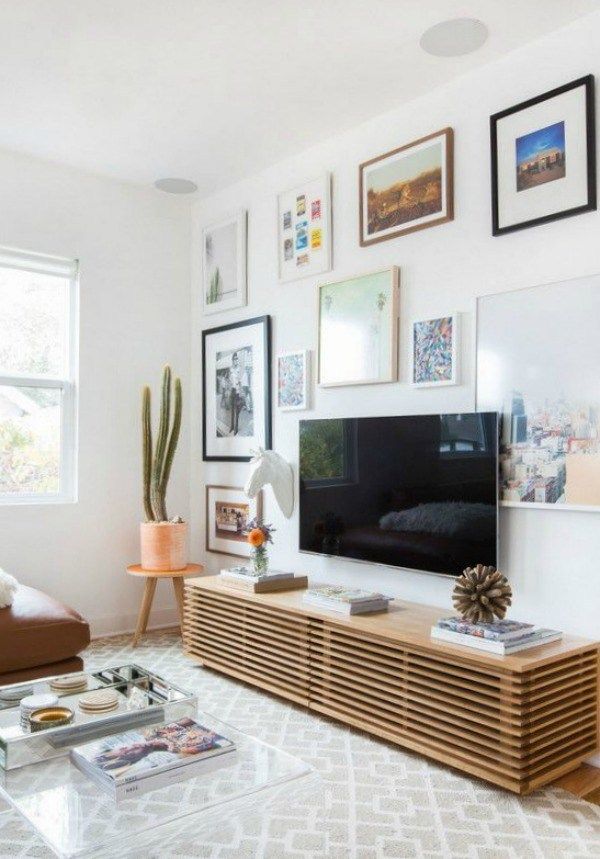 This could be a tall dresser or a favorite furnishing of yours, and it should be right across from the foot of the bed. In less spacious bedrooms, put the television inside a cabinet or on some other piece of furniture that’s proportional to the area. Avoid placing the TV in the corner of the room or on a small furniture piece.
This could be a tall dresser or a favorite furnishing of yours, and it should be right across from the foot of the bed. In less spacious bedrooms, put the television inside a cabinet or on some other piece of furniture that’s proportional to the area. Avoid placing the TV in the corner of the room or on a small furniture piece.
Just like in your living room, you could mount the television on the wall, as long as the spot you choose will not interfere with your artwork or other décor. You could also hang it from the ceiling on mounted brackets. If you’re feeling crafty, you could select a smaller TV model and put it on top of an adjustable post at the end of the bed. This will allow you to rotate the screen or lower it when not in use. You could mount the TV on the wall on an adjustable arm close to the bed, or those who are creative could even incorporate it into a room divider.
Don’t give yourself a neck ache trying to sit up to see a movie. Get a support pillow or prop chair for your bed to enable you to watch TV more comfortably.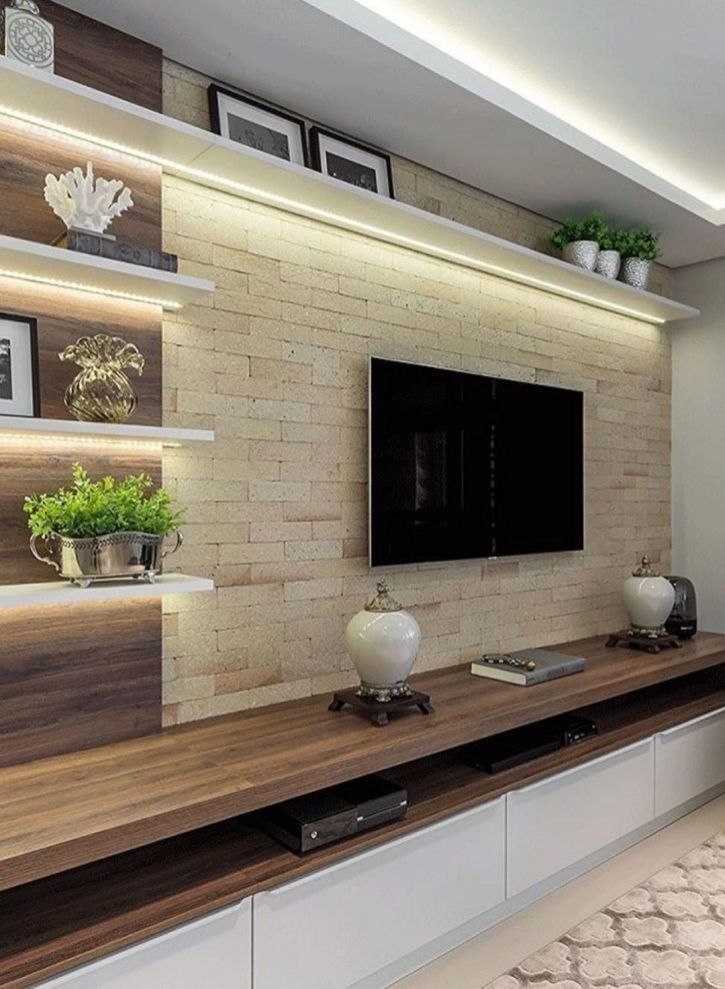 If you have an adjustable bed, reconfigure your flat mattress to accommodate your viewing. Consider installing surround sound in your bedroom with speakers close to the bed or on the nightstand so you don’t have to crank the volume up. You could also purchase a pair of wireless headphones if your partner has to go to sleep earlier than you do or they want to do another activity in the same room as you.
If you have an adjustable bed, reconfigure your flat mattress to accommodate your viewing. Consider installing surround sound in your bedroom with speakers close to the bed or on the nightstand so you don’t have to crank the volume up. You could also purchase a pair of wireless headphones if your partner has to go to sleep earlier than you do or they want to do another activity in the same room as you.
It’s wise not to watch TV in total darkness, so when you shut off the screen and the lights your body will be ready for bed. To combat the feeling of mental alertness a TV in a dark room can bring, use a table lamp to create a soft glow in the room or install a dimmer switch so you can change the level of lighting in your room.
Where to Put the Television in a Small Home
Perhaps your house or apartment is a little short on square footage. If it makes you happy, that’s all that matters, but you may still feel like a TV doesn’t exactly fit into your floorplan. There are plenty of ways you can camouflage a television in your living space to keep it from feeling awkward or getting in the way.
There are plenty of ways you can camouflage a television in your living space to keep it from feeling awkward or getting in the way.
Place your television on top of a vintage desk or inside an attractive wardrobe — bonus points if the furniture is in a bold color. This will add personality to the room, catch the eye more than a traditional media center and distract from the TV itself. If your living room features low seating, you can tuck the TV inside a console table so it can still be watched when you’re lounging, but it isn’t front and center in the room. You could even try mounting it on a swing arm for greater design versatility.
One genius idea for helping your TV blend into a room is creating a gallery wall around it. Surround your television with paintings, prints and photographs and either mount it on the wall or put it on top of a short piece of furniture. If you want to take this one-step further, you could accessorize it with table lamps, plants, candles or any other decorations you have on hand.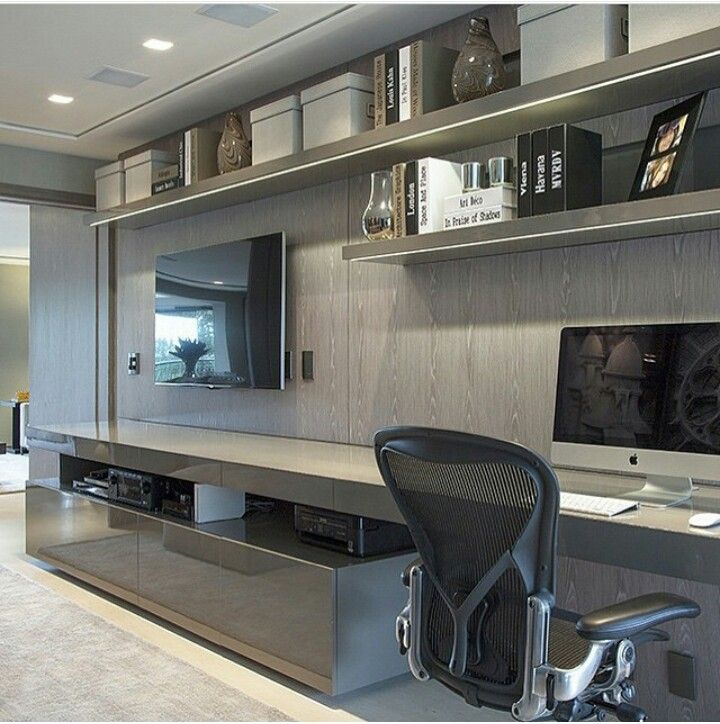 That way the TV will just look like part of the group.
That way the TV will just look like part of the group.
Stick the television in your bookshelf among your books, if it’s small enough, or hide it in tiered shelves that hold collectibles so the eye is drawn to the collection. You could also consider dwarfing the TV with an impressively big piece of artwork in the background or beside it.
Another handy trick is to position the TV against a dark-colored wall or patterned wallpaper. You can paint the inside of the bookshelf or cabinet it’s in, if you want, so it will blend in and not look out of place. When all else fails, simply put the TV in the largest living area you have, even if that ends up being an unexpected place like the kitchen. Positioned inside a small niche in the wall or your kitchen cabinetry, it will fit right in with the rest of the room.
Further Design Tips
The best interior designs incorporate your TV from the very beginning. That includes positioning it near the electrical outlets and internet hookups it needs.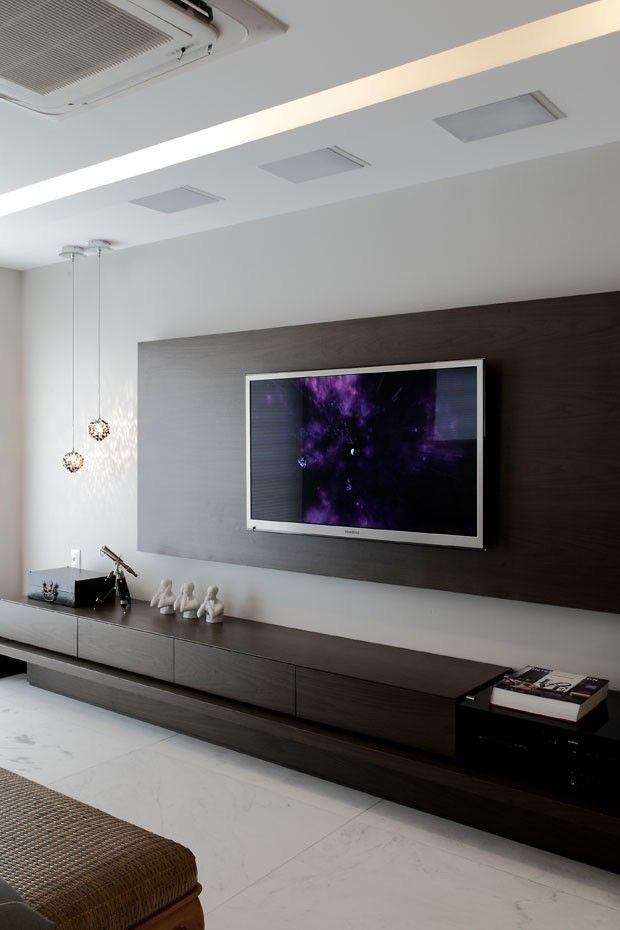 You should also go into any television installation with all the cables necessary or the correct type of fasteners for hanging it on the wall.
You should also go into any television installation with all the cables necessary or the correct type of fasteners for hanging it on the wall.
When wall mounting, you should take time to prep beforehand. Is the wall suitable for TV mounting, or will installation damage the wall? Create guide holes for securing your fasteners and check to see if your mount and TV will be level. You have to ensure your television is plumb before you put your tools away, as this position is likely to be permanent.
It is best to buy entertainment furniture that will coordinate with the rest of the furniture in a room. You could consider custom cabinetry to seamlessly incorporate the TV into a living space and make it as unobtrusive as possible. Another idea is to reimagine a favorite piece of furniture, such as an armoire, as media storage. You may need to rework its doors or install shelves inside, of course, but then it could hold a television along with your DVD or Blu-ray collection.
Your home might already feature recessed areas designed for flat-screen televisions.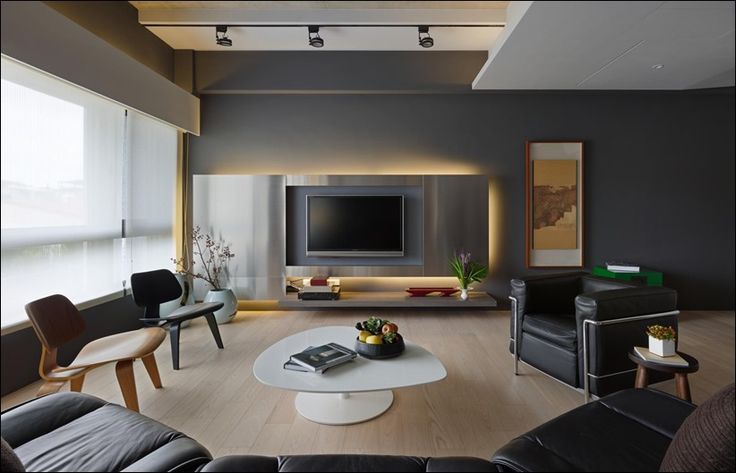 However, if your TV doesn’t fit into these premade openings, don’t be shy about calling a carpenter to enlarge them or create another recessed area that better suits your needs. If you have a larger, old-fashioned television, you can still utilize it in a way that doesn’t feel out of place with your contemporary living area. For instance, you could place your traditional TV on a short shelving unit at an angle, then position your couch perpendicular to it for viewing.
However, if your TV doesn’t fit into these premade openings, don’t be shy about calling a carpenter to enlarge them or create another recessed area that better suits your needs. If you have a larger, old-fashioned television, you can still utilize it in a way that doesn’t feel out of place with your contemporary living area. For instance, you could place your traditional TV on a short shelving unit at an angle, then position your couch perpendicular to it for viewing.
Through this article, you have learned where to put the TV in a living room or bedroom, as well as design tips for working around fireplaces, windows and smaller spaces. If you are still at a loss as to how to tackle your unique situation, visit one of the Davids Furniture showrooms. Our interior design experts are ready to answer any questions you may have and suggest furnishings that will fit your needs. We have locations in Harrisburg, PA and Mechanicsburg and we would love to help you in whatever way we can. Contact us today!
page updated 2/24/2020
TV in the Living Room: Five Common Mistakes
Tips
Mistake #1: TV in the Spotlight
The modern TV is a real marvel of technology, but putting it at the forefront and making it the central object in the living room is not worth it. Especially when it comes to black minimalist XXL models in a classic living room.
Especially when it comes to black minimalist XXL models in a classic living room.
The TV doesn't have to be the main focus of the room.
Tip:
Instead of building your interior around your TV, start with furniture, accessories and details. Let them be the main ones, and the TV will take its modest place in it. Yes, in the modern world one cannot do without it, but it is far from the only important object in the living room, but only one of its components.
Mistake #2: The TV doesn't fit in the room
Have you bought a trendy, ultra-modern model, but it doesn't fit in your living room at all and looks out of place next to other furnishings? Unfortunately, this often happens.
The right furniture, accessories and decor will help fit the TV into the space and make it an organic part of the interior.
Tip:
Always start with your room's baseline when choosing a TV. If the living room is spacious and the sofa is far from the screen, the TV should be large. If the room is small and the screen is close to the "seats", choose smaller models. A huge "black square" in a small space looks alien and spoils the whole impression of the interior.
If the room is small and the screen is close to the "seats", choose smaller models. A huge "black square" in a small space looks alien and spoils the whole impression of the interior.
Error #3: The TV is hanging too high
One common mistake is to install or hang the TV too high. In this case, it is inconvenient to watch it, and you will always feel discomfort.
Do not set the TV too high. The screen should be at eye level.
Tip:
Wherever your television is placed or hung, it should always be placed at eye level. Otherwise, it will be uncomfortable to use it. Therefore, before installing it, sit or lie down on the sofa and look straight ahead (without lifting your head or lowering your head): this is where the screen should be. Remember, the right place for equipment is the key to your comfort.
Mistake #4: An Ugly TV Stand
Standard modern AV furniture doesn't suit every style. Sometimes it can ruin the whole look of your living room.
Choose a beautiful piece of furniture that can double as a TV stand.
Tip:
The TV does not have to rest on a standard TV stand. It's time to abandon the old stereotypes! For this purpose, almost any furniture is suitable. A chest of drawers, a console, a bookshelf or a side table - all this can easily serve as a stand for your equipment! And you can make special holes for cables yourself or simply do not move the furniture close to the wall so that there is room for wires behind.
Mistake #3: The TV is not integrated into the interior
The desire to combine furniture, appliances and accessories into a single whole is a good way to achieve a harmonious interior. But a TV is a living picture, and inscribing an image is usually more difficult than just a static object. Many give up this idea, and as a result, the space loses its integrity, and the entire interior falls apart.
Fit the TV into the hanging pictures or photographs on the wall, why not?
Tip:
Don't let your TV become an ugly black stain that ruins all the beauty in your room.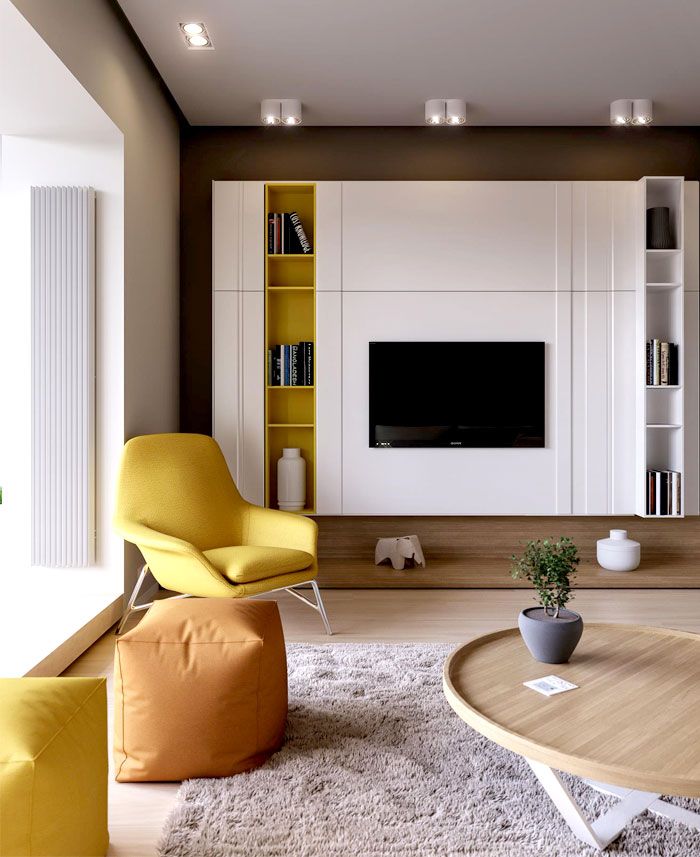 A flat panel can be decorated with a baguette and hung on the wall among other paintings, photographs or drawings. By the way, Samsung has a Frame model with a choice of different wooden or lacquered frames. This TV itself looks like a picture!
A flat panel can be decorated with a baguette and hung on the wall among other paintings, photographs or drawings. By the way, Samsung has a Frame model with a choice of different wooden or lacquered frames. This TV itself looks like a picture!
Frame 2018 TV from Samsung.
Frame 2018 TV from Samsung.
Tags
- Living room
🔥 Living room design with TV (161 photos) - see the best ideas for your apartment from a design studio in Moscow!
Placement of the TV in the living room . The large flat screen looks stylish and does not overload the design of the living room, and the TV will fit perfectly into the interior of any apartment.
Location . Remember, as a child, your parents scolded you for watching cartoons too close? Fortunately, modern models are designed in such a way that you can even place a TV in the living room close to the sofa. The main thing is to look at the whole picture at once. It doesn’t matter if your room has a sofa, an ottoman or comfortable armchairs: the TV in the living room design will logically fit against the wall opposite the resting place.
It doesn’t matter if your room has a sofa, an ottoman or comfortable armchairs: the TV in the living room design will logically fit against the wall opposite the resting place.
Cabinet or bracket? Hang your TV in the living room on a bracket if you want more lightness, or put it on a cabinet - there is no universal rule here. What is really worth taking care of is the wires. Even the most stylish interior design is easily ruined by dangling and protruding cables. A pre-provided cable channel will help to cope with this problem. He will hide all the flaws, and the wires will not disturb the harmony of the interior of the living room with a TV.
Height from floor . The specific TV height may vary depending on the height of your sofa or personal preference. At the same time, there is a universal rule: for comfortable viewing, the distance from the floor to the center of the screen should correspond to the level of the eyes of a seated person and be 100-120 cm.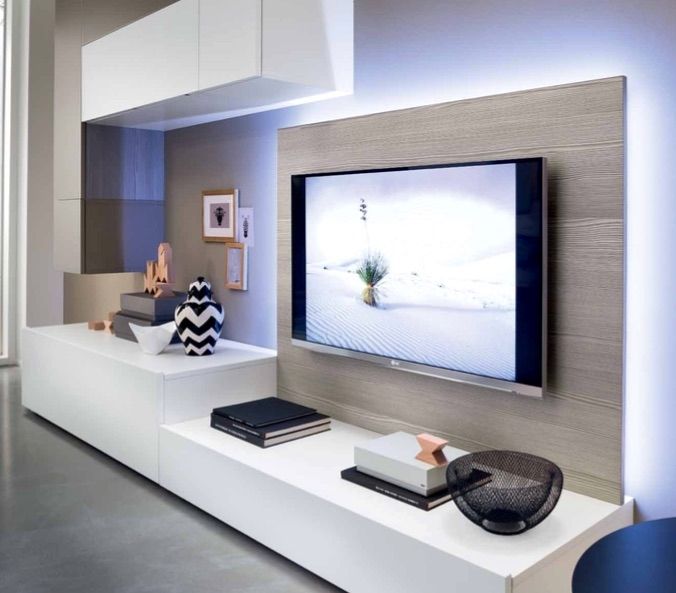
Diagonal size . Choose a technique depending on the budget and the size of the room. But if in your design the TV will be the defining element on the living room wall, then its diagonal should be at least 50". Otherwise, the feeling of an empty, bare wall will remain.
Movie projector as an alternative to . The projector will be a great alternative to the TV in the design of the living room, if the walls of your room are white or light beige without visible relief. In other cases, you can not do without a special screen. Budget options will have to be manually deployed every time you want to watch a movie. More expensive screens work from the control panel. The projector itself is mounted against the opposite wall and can be removable or permanent. Finally, when choosing this alternative, you will have to take care of the curtains. If you are going to arrange movie shows not only at night, you cannot do without thick blackout curtains. Without them, the picture on the screen will be dull and faded.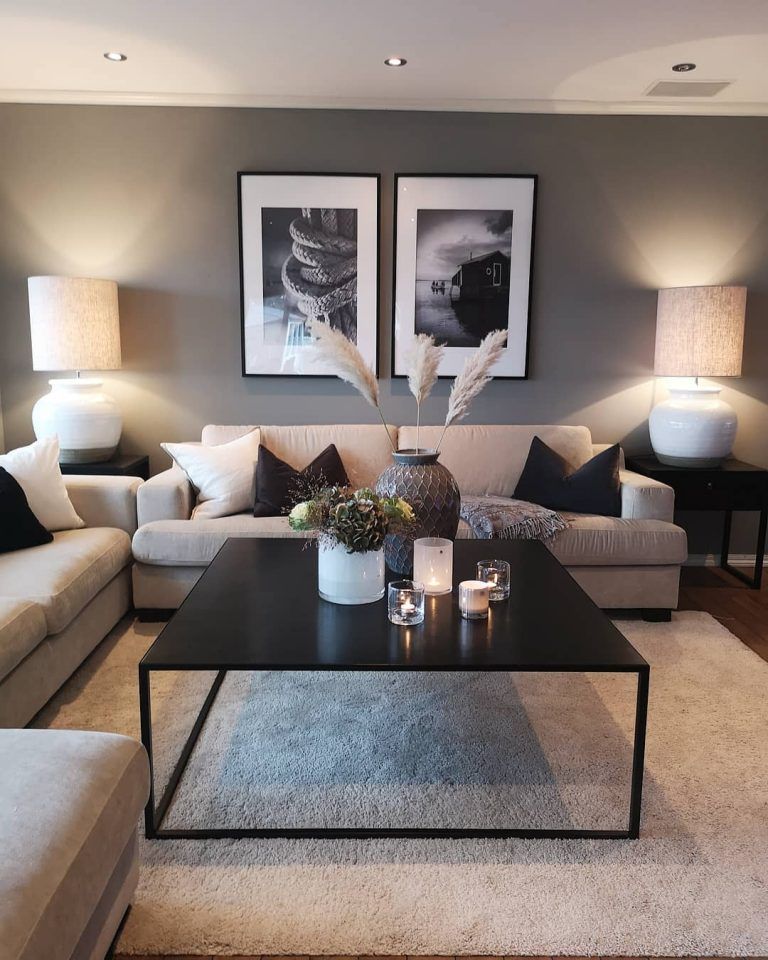 Be sure to hide the wires from the projector in the cable channels!
Be sure to hide the wires from the projector in the cable channels!
Read more
161 photos of the best ideas!
Living room design with TV
Looking for Living room design with TV? I tried and picked up for you not just a selection of ideas from the Internet, but the best works of interior designers from our studio!
The place of the sofa
in the design of a living room with a TV
Thinking over the design of a living room with a TV, make it a schematic sketch . This will save you from unexpected inconsistencies and help you assess the situation from the outside. Display the layout, the location of windows, doors and future furniture on the diagram, keeping the scale.
Draw an imaginary line from the window to the door . This is a place where drafts walk, which means that putting a sofa here is not safe for health.
Sofa arrangement in living room . Determine the main function of your sofa.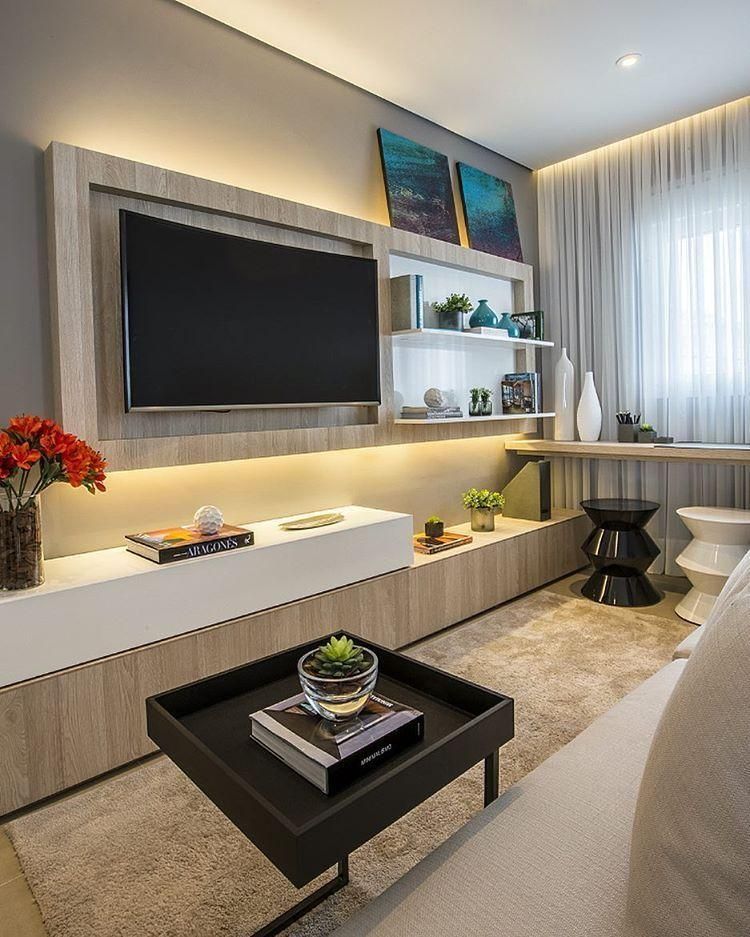 Are you going to watch TV in the living room every evening? Maybe guests will often spend the night on the sofa? Depending on the role, its place in the interior may change. Take a look at some layout ideas:
Are you going to watch TV in the living room every evening? Maybe guests will often spend the night on the sofa? Depending on the role, its place in the interior may change. Take a look at some layout ideas:
1. The ideal location for furniture to perform its function to the maximum: a sofa in the living room opposite the TV or diagonally from the door. Encourages you to sit down and rest.
2. A good solution for those whose guests like to stay until the morning is a sofa near the door. It is hidden behind a wall, the door overlooks the TV. With such an arrangement in the living room of your kopeck piece or treshka, a feeling of comfort is preserved.
3. If the sofa is a corner sofa, the best place for it is at the far end of the room from the entrance. Thus visually it fits into the natural boundaries of the room, does not overload the interior of the living room with a TV, and you maintain a sense of spaciousness.
Correct opening of the living room door
In or out?
Living room door opening . You can “hide” the door with the help of the right color: if the color of the door and the walls match, then the exit will become part of a single living room space with a TV and will not attract attention. Choose a model without platbands, they will not create extra relief at the edges and will help you complete the main task.
You can “hide” the door with the help of the right color: if the color of the door and the walls match, then the exit will become part of a single living room space with a TV and will not attract attention. Choose a model without platbands, they will not create extra relief at the edges and will help you complete the main task.
When installing the door, make sure that it opens easily and does not interfere with free access to and from the living room. If the door intersects with the furniture when you open it and there is no way to avoid this, consider alternative options. Today, models of sliding compartment doors and folding doors-"books" are presented on the market. They are especially good when you have to save usable space.
See what designers offer:
1. Not the worst design option. When opening the door, you can hit the cabinet doors, but the savings in the space of the apartment are obvious: the door opens inward, and not into the corridor, where there is not too much space anyway.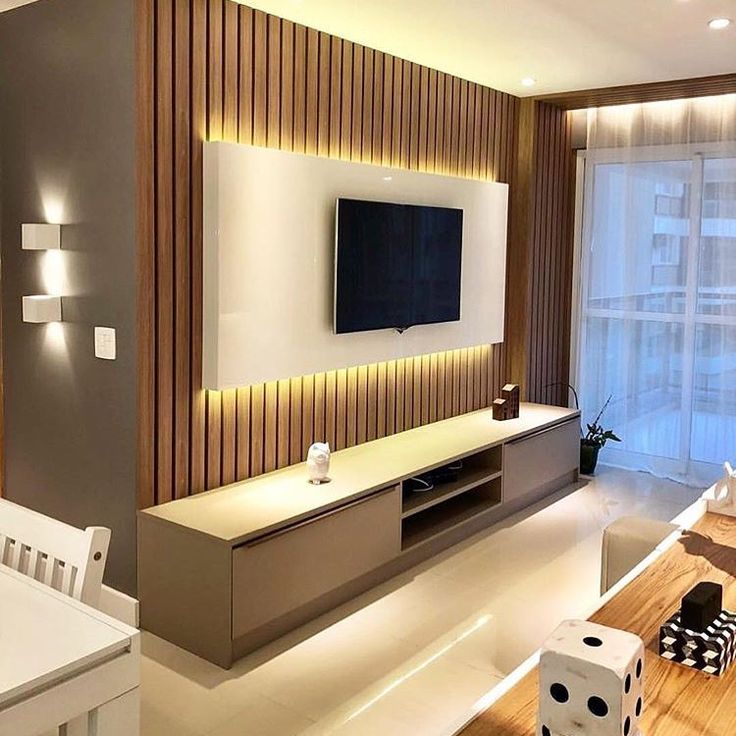
2. Unfortunate choice: swinging open, the door blocks the free space. It is better to change direction or choose one of the alternatives described above.
3. Another bad design option, but now the door “eats up” space not in the living room itself, but in the corridor. If the renovation or layout does not allow for a change of direction, it may be better to install an accordion folding door or sliding doors.
4. Good location. The door opens without interfering with entry and exit, does not take up much space both in the corridor and in the living room.
Living room furniture
Living room furniture . On the one hand, the armchair matches the style of the restrained classic design of the living room. On the other hand, a bright blue color creates the necessary accent, and the interior no longer seems boring.
- Armchair. The design studio often proposes to make the armchair the main accent of the living room interior.
 Play with colors and styles. For example, a baroque armchair in a minimalist living room will definitely attract attention. Don't like radical solutions? Choose an armchair in the same style, but in a contrasting shade, for your two-room apartment. The dimensions and model should meet your ideas about comfort. You can climb into a wide easy chair with your legs covered with a blanket. In the recliner model with a reclining back, it is convenient not only to relax, but also to take a nap. A more strict design with a high back and armrests is suitable if you do not plan to sit in a chair watching TV in the living room for a long time.
Play with colors and styles. For example, a baroque armchair in a minimalist living room will definitely attract attention. Don't like radical solutions? Choose an armchair in the same style, but in a contrasting shade, for your two-room apartment. The dimensions and model should meet your ideas about comfort. You can climb into a wide easy chair with your legs covered with a blanket. In the recliner model with a reclining back, it is convenient not only to relax, but also to take a nap. A more strict design with a high back and armrests is suitable if you do not plan to sit in a chair watching TV in the living room for a long time. - TV stand. In the past, a living room and TV always meant a cabinet. Now wide massive TV cabinets have sunk into oblivion along with bulging TVs, tape recorders and cassettes that take up a lot of space. A light narrow shelf or a combined pedestal-shelving unit is the right solution for a modern kopeck piece.
- Coffee table.
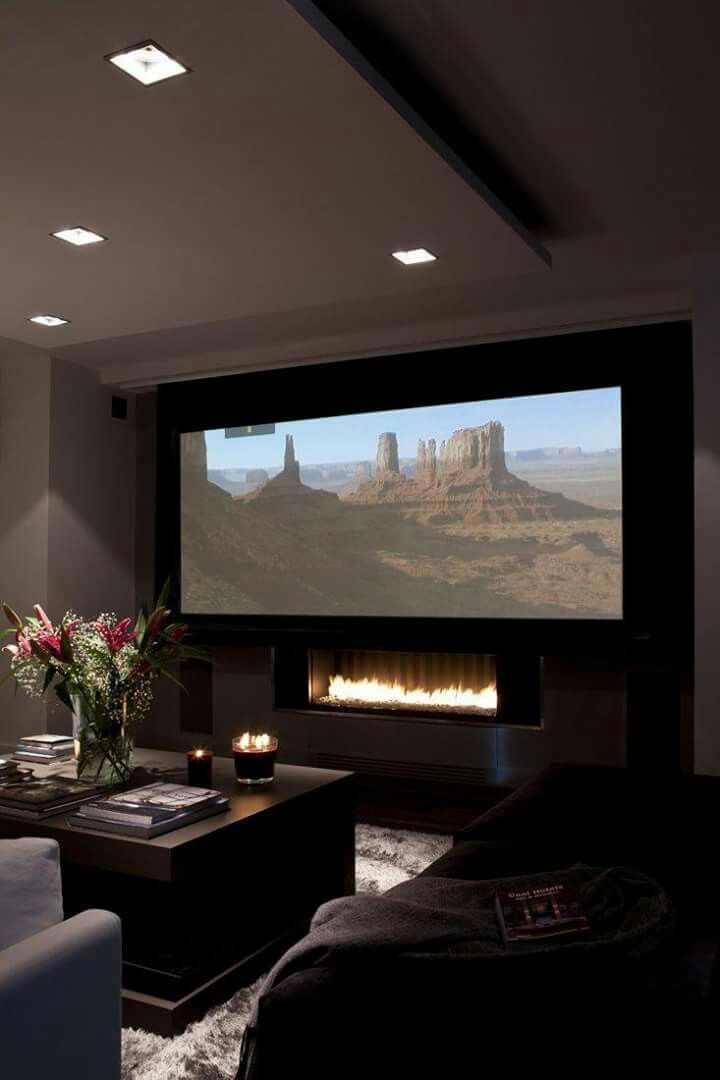 Original design coffee table will not only create coziness and decorate the living room. It can also easily become an art object, one has only to find a suitable option. Connoisseurs of space saving will like a transforming table. It easily turns into a high and wide table for receiving guests.
Original design coffee table will not only create coziness and decorate the living room. It can also easily become an art object, one has only to find a suitable option. Connoisseurs of space saving will like a transforming table. It easily turns into a high and wide table for receiving guests. - Side tables. Solution for the interior of a small living room with TV - side table. It takes up less space than usual, easily moves from sofa to chair and at the same time successfully copes with its function. A couple of books, a cup of coffee or a candy bowl will fit on it.
- Rack. A useful find, no matter what interior design you choose. The rack is your personal exhibition. Books, small useful things, souvenirs, figurines, just cute little things: fill it with what makes you feel good. At the same time, it is important to observe the measure and not litter the shelves. If the layout of the room requires zoning, the rack will perfectly cope with this task.
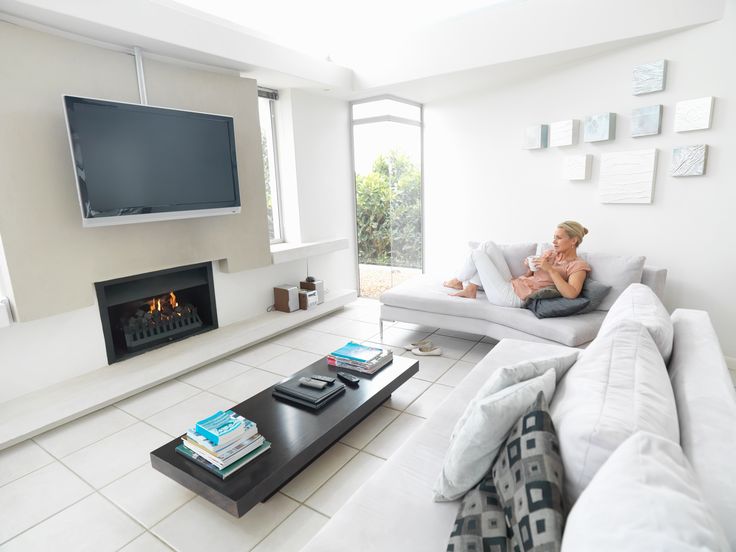 Unlike thick screens and additional walls, it allows light to pass through and does not weigh down the space.
Unlike thick screens and additional walls, it allows light to pass through and does not weigh down the space. - Additional storage cabinet. In a wide room there is enough space not only for organizing recreation. Place the sofa closer to the center of the living room with a TV, and use the freed up space for a wardrobe. In Moscow, apartments are often rented out with construction flaws. Turn them to your advantage: niches and walls can also be used to store things.
- Fireplace. We are, of course, talking about electric fireplaces. Modern models can perform many functions at once. First, the fireplace is beautiful. Secondly, in the cold season, it replaces the heaters. Thirdly, some models can also work as humidifiers, which is especially important in winter, when the batteries dry out the air. If you decide that you need a fireplace, you will have to choose from three main styles: antique, classic and modern. The size of the fireplace also matters, it depends on the size of the room and the height of the ceilings.
 Designer's advice will help you choose the right option and not spoil the overall style of the living room.
Designer's advice will help you choose the right option and not spoil the overall style of the living room.
Kitchen + living room
If you have a tiny kitchen and a small living room, try combining them. So you get a spacious and bright kitchen-living room. This option is not suitable for everyone, but recently it has become more and more fans.
Kitchen-living room design . When placing accents in the interior of a modern kitchen-living room, do not be modest, choose several color shades at once.
As a result of combining the rooms, we will get a space with two windows, which means there will be more light and air here. There will also be a dining area. To choose the right dining table for her, count on a person of at least 70 cm. When there is not enough space for a full-fledged table, options with a folding transforming table or a bar counter will come to the rescue. By the way, the latter can visually separate the kitchen and living areas.
Ideas for a kitchen-living room
Bedroom + living room
The option of combining a living room with a bedroom is less common. This solution is not for everyone. Still, in the bedroom you want privacy, and the living room is a room where guests often visit. It is better to take a closer look at this redevelopment option for young owners of small apartments. Families with twos and threes should avoid this option. Do you want to zone the space without losing lighting and functionality? Use a rack. It will not only divide the room, but also help to place books and souvenirs.
Bedroom design with living room . See how you can successfully combine the bedroom and living room in a single room. The rack is used for zoning the room.
Living room + office
Unless you are a happy owner of a spacious three-room apartment, then most likely you will not be able to allocate a separate room for an office. Most often, the desktop is placed in the living room or bedroom.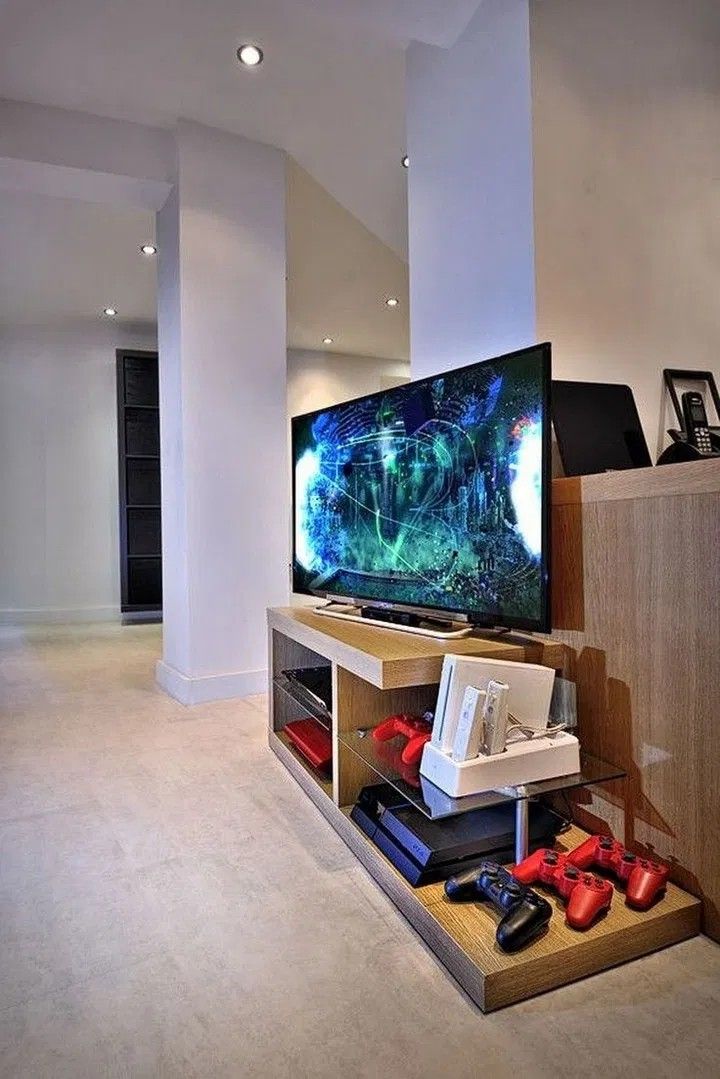 When choosing a table and its location, be guided by how often it will be needed for work. Remember that a desktop computer requires a more spacious workplace than a laptop (an average of 60-70 cm deep), and also take care of sockets and cable channels in advance, during repairs.
When choosing a table and its location, be guided by how often it will be needed for work. Remember that a desktop computer requires a more spacious workplace than a laptop (an average of 60-70 cm deep), and also take care of sockets and cable channels in advance, during repairs.
Living-study design . An example of a project with a bright accent on a chair. A small work table and shelves match the color of the wall and do not draw attention to themselves.
Take a look at some of the living room desktop options.
1. If you don't use your desk very often, it's best to make it discreet by color or zoning. For example, you can choose a countertop in the color of the walls, hide the workplace behind a screen or disguise it with a rack.
2. If a freelancer needs a large table for a desktop computer, an extended window sill is ideal. The tabletop in the width of the room visually pushes the walls apart. This excellent solution will adjust the proportions of the living room in the form of an elongated rectangle.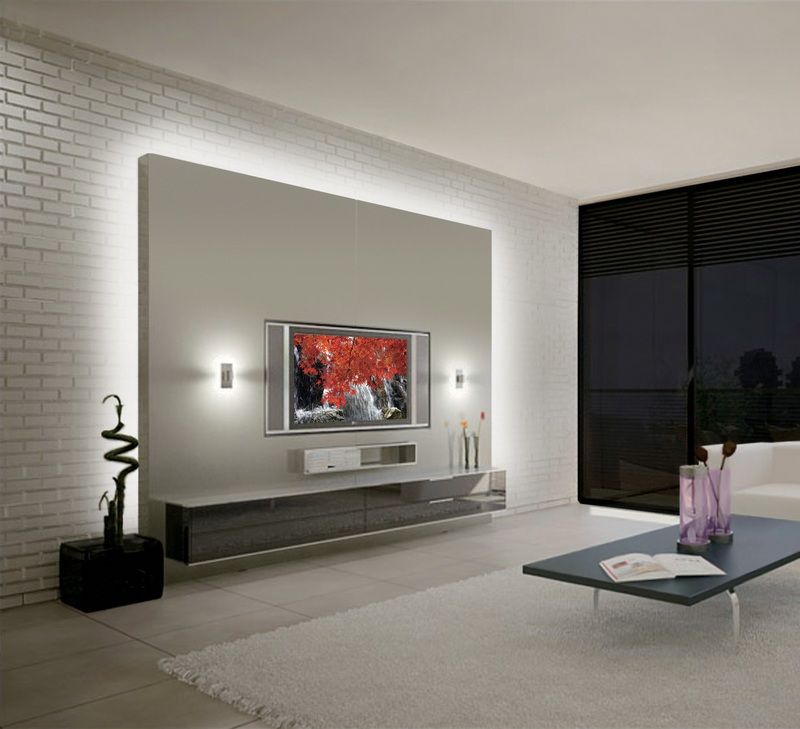
3. For creative people and schoolchildren, a desktop built into a wardrobe is suitable. The hinged door doubles as a table top. Firstly, it is a way to quickly hide the creative mess from prying eyes while maintaining the illusion of cleanliness. Secondly, it is also space saving.
Work table in the interior
Air conditioner
in the living room with TV
How to position the air conditioner so that it fits well into the interior of the living room? First of all, it is important to place it correctly. Do not hang the air conditioner over a sofa or armchair where people often sit. Just moving it to the far end of the room will not work either: you will have to ditch the wall from the window to the attachment point, and this is quite expensive.
Air conditioner indoor unit is difficult to fit into the interior. A white air conditioner hanging on a white wall attracts the least attention.
Most often, the design project involves one of the following options for the location of the air conditioner:
1.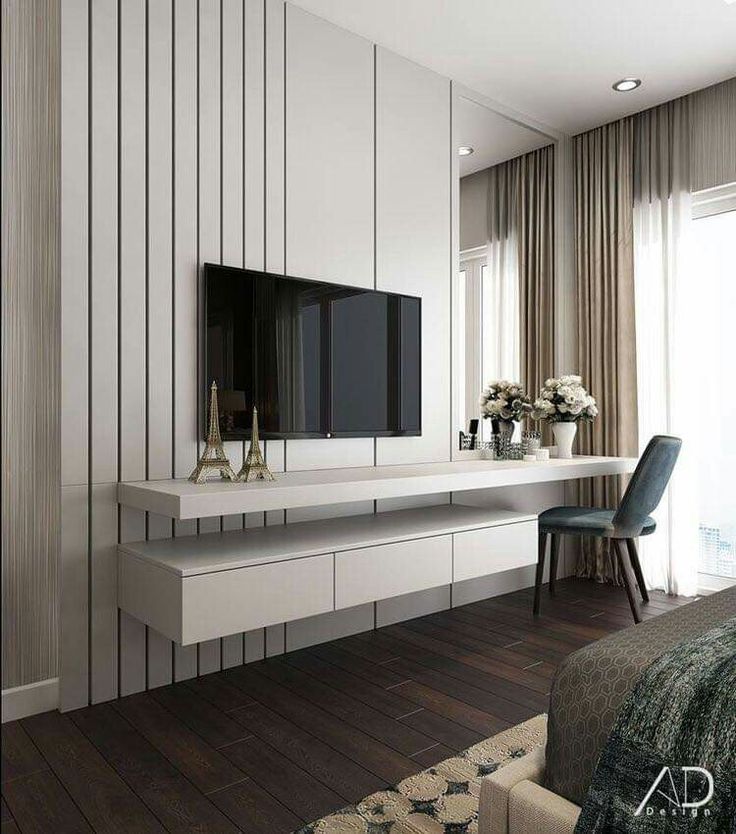 Air conditioning above the front door. Excellent location, although it requires gating for communications.
Air conditioning above the front door. Excellent location, although it requires gating for communications.
2. Indoor unit close to the window. Unlike the first option, you will have to grind less, which means that this option is more economical. The disadvantage is that the cooled air blows on the chair.
3. The air conditioner is located in the most active area of the room. With this design of a living room with a TV, cold air hits people directly.
Sockets
in the design of the living room
When you calculate the number and location of sockets, the interior design should already be thought out. At least the position of furniture, appliances and stationary lamps (floor lamps and table lamps). The average number of sockets for a living room with a TV is about 15. Decide where the TV set-top box, game console, sound system will be located. It is convenient to hide sockets behind the TV screen or TV stand. If the design project implies the presence of a fireplace, 2-3 sockets can also be placed behind it. Don't forget the Christmas tree. In the intended place of its installation, there should be enough sockets for electric garlands.
Don't forget the Christmas tree. In the intended place of its installation, there should be enough sockets for electric garlands.
Lighting
in the living room
Light decides! It is from its brightness and shade that our feeling of the room changes: it is cozy, spacious or dark and inhospitable. Consider several options for lighting a living room with a TV for different situations: a relaxing evening, receiving guests, watching a movie.
Living room lighting . The loft style in the interior of this living room is set by a brick wall, and several lamps of various types support it.
Luminaires . When choosing lamps, consider the style of the interior. In the design of a living room with a TV, it is fashionable to combine lighting fixtures of different sizes and functionality, united by one style. In the living room, it is best to install three types of lighting (spot, local and intimate), which at the click of a button will turn a bright, bright room for meeting friends into a cozy corner for relaxation.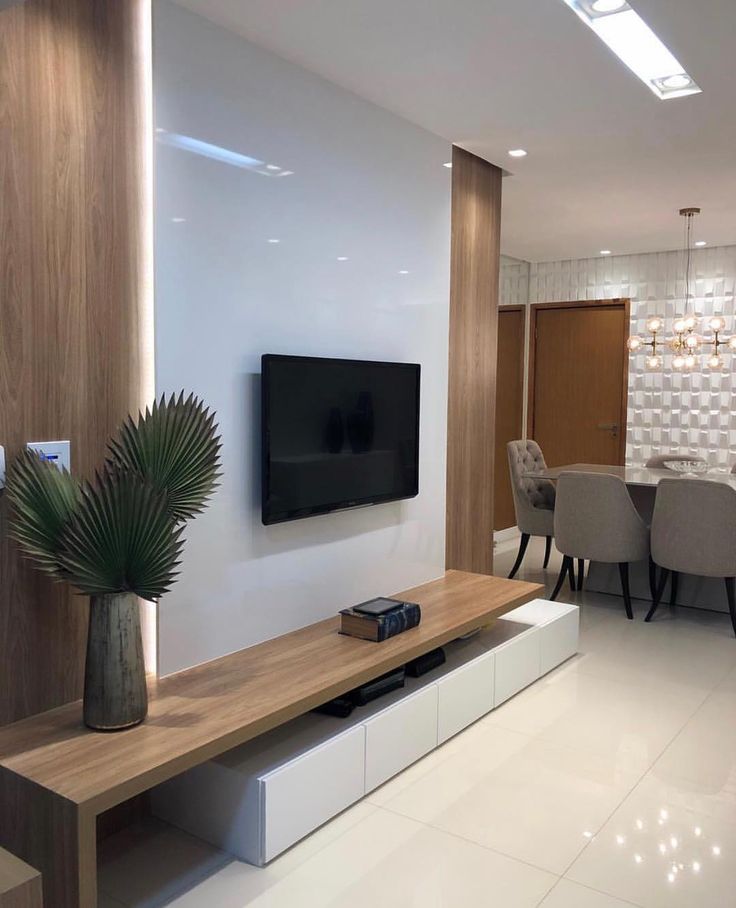
Top light . The main type of lighting, the so-called overhead light, is represented by spotlights (they are also called work lights) and a chandelier. A spectacular chandelier can perform not only its main function, but also be an important part of the design, set the accent of your living room interior with a TV.
Table lamps, floor lamps and sconces - this is the so-called spot light . However, it should be noted that sconces rarely fit into modern design. Try replacing them with a pair of stylish lamps.
Intimate light . Subdued light elements not only illuminate the room, but create an atmosphere of romance and comfort. If guests stay overnight, then interior garlands with their warm, even light can serve as night lights.
Candles . The most interesting thing in interior design look large plain candles. However, they can be of different diameters and heights. White color and matte finish is the perfect combo for most living rooms.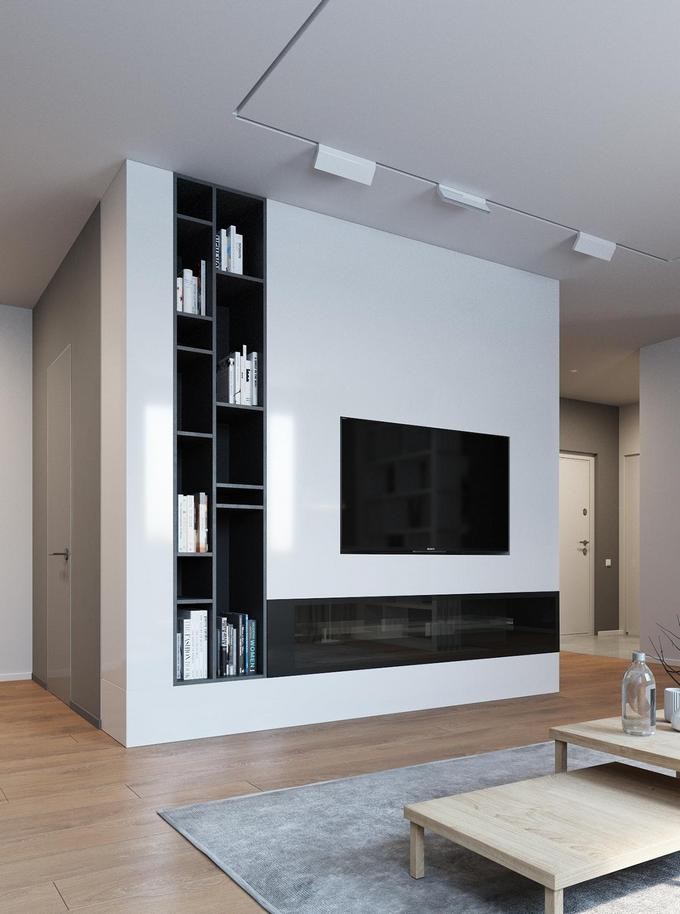
Zoning . The combined rooms are divided into zones not only by shelving and screens. Light often comes to the aid of designers. In the kitchen-living room, be sure to hang a few lamps above the table. This rule works for both the bar counter and the classic dining table. For the working kitchen area, also choose working lighting. Use standard lighting techniques in the living area: a combination of overhead light with local lighting in the form of floor lamps and lamps.
Contemporary living room
The modern design style of the living room with TV is versatile, combining minimalism and versatility. It is suitable for both large and small spaces.
Contemporary living room design . The clarity of lines and the presence of strict patterns are the hallmarks of modern style.
Style . Modern style is easy to recognize by its characteristic colors. It is almost always represented by monochrome shades (black, gray, white) combined with bright accents. If you do without them, then the interior of the living room with a TV will become faceless and boring. In addition to color accents, designers use large bright posters and paintings in the same style. Decor should not be much. As already mentioned, modern style is characterized by minimalism. Furniture should meet two parameters: convenience and simplicity.
If you do without them, then the interior of the living room with a TV will become faceless and boring. In addition to color accents, designers use large bright posters and paintings in the same style. Decor should not be much. As already mentioned, modern style is characterized by minimalism. Furniture should meet two parameters: convenience and simplicity.
Lots of modern living rooms
Neoclassical style in the living room
Many people ask an interior designer to decorate a room in neoclassical style. This is a kind of modern take on the classic design of the apartment. It is distinguished by a large number of decorative elements. Examples include moldings on walls and ceilings, carved lamps, a “carriage tie” on upholstered furniture. The colors in the neoclassical style are pastel, soft.
Neoclassical living room . Pillows of different sizes are a type of decor that is appropriate in both modern and classic living rooms.
Style .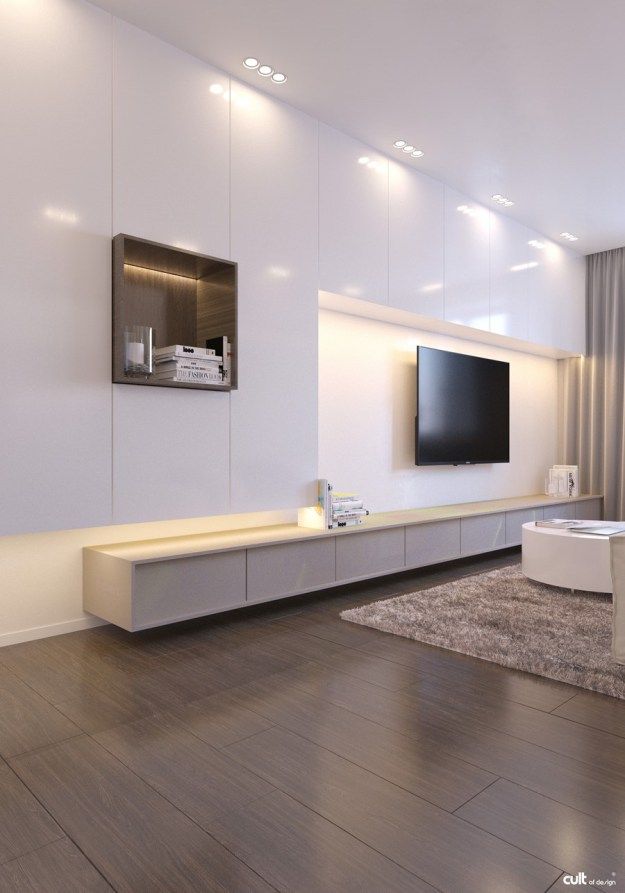 In the neoclassical style, as in the classical one, the correct symmetrical lines and decorative elements are combined. Moreover, there can be many accessories: these are ceiling and wall moldings, draperies, stucco, carved elements in furniture. Windows, as a rule, darken heavy curtains and drapes.
In the neoclassical style, as in the classical one, the correct symmetrical lines and decorative elements are combined. Moreover, there can be many accessories: these are ceiling and wall moldings, draperies, stucco, carved elements in furniture. Windows, as a rule, darken heavy curtains and drapes.
Neoclassical living rooms
Other living room styles
Scandinavian style
Fusion
Loft
Colors
Beige in the design of the living room with TV
Bright living rooms with loud accent colors, original design projects using different shades and a dark leading color are by no means uncommon when designing an apartment. There is no rule that a living room with a TV must be bright, although for a number of reasons, light colors prevail in modern designs. In this article, we will focus on such options as the most common.
Beige visually expands the space . Today apartments are mostly small.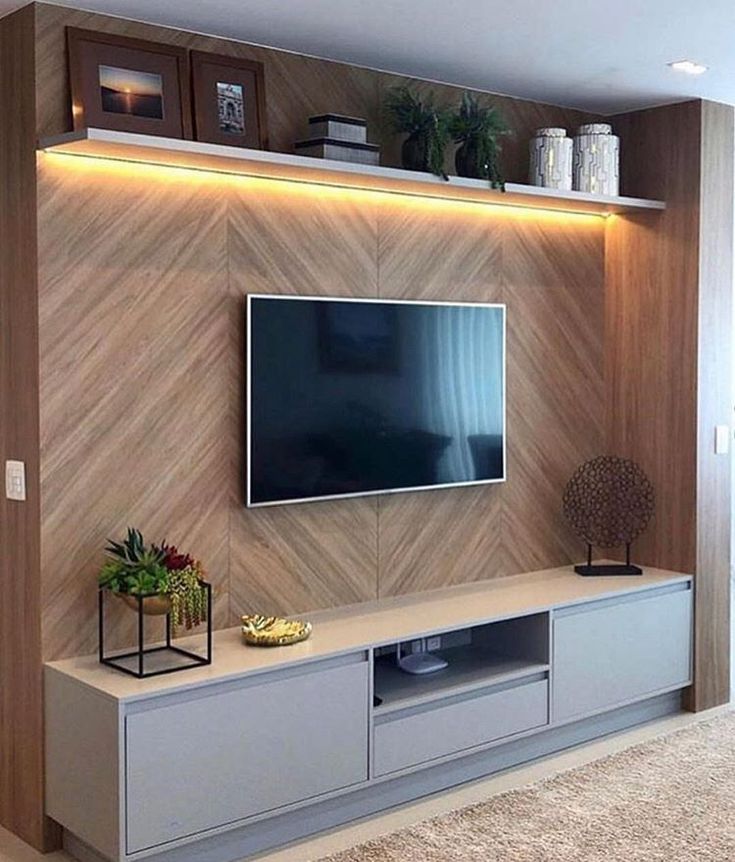 If this is your situation, follow the designer's advice: beige can fix the problem.
If this is your situation, follow the designer's advice: beige can fix the problem.
Compatibility . The compatibility of beige with almost any other color makes it universal. It gives you freedom in choosing furniture and decorative elements: no matter what shade you use in the interior of the apartment, beige will be combined with each of them.
Create an atmosphere of warmth and comfort . Beige shades do not irritate the eyes, you do not get tired of them. This design is not boring, but you can dilute it with bright decorative elements.
Beige in the living room . In a classic interior, warm shades of beige are more common. Interior designers in a modern style prefer colder tones.
Selection of beige living rooms
Gray living room
Gray living room . Looking for a neutral color for a modern living room? Choose grey!
The thoughtless use of colors in the design of a living room with a TV can be a serious mistake.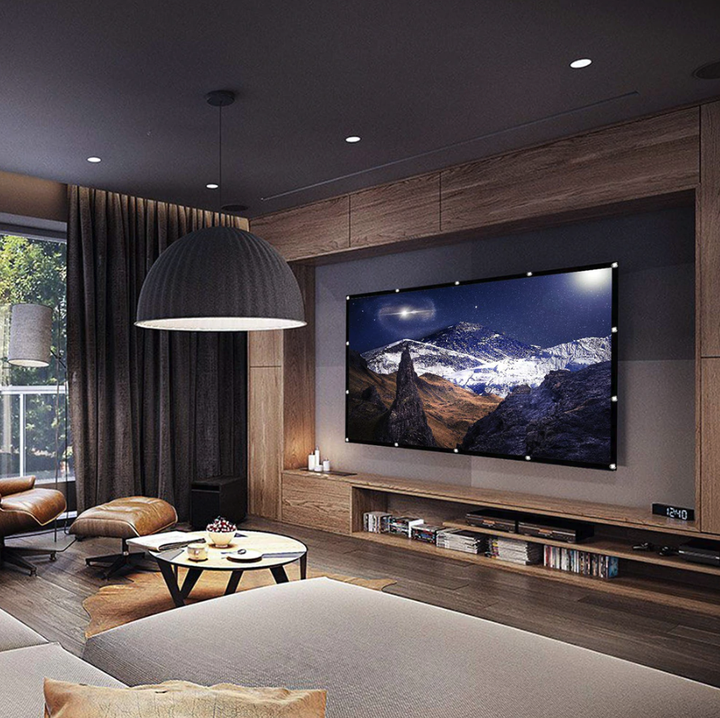 Deep dark tones absorb light. They can make an already small room quite small and gloomy. Medical sterility will bring an abundance of white. Choosing a harmonious neutral color, it is better to dwell on gray. It goes well with many bright and delicate shades, does not irritate or tire the eyes.
Deep dark tones absorb light. They can make an already small room quite small and gloomy. Medical sterility will bring an abundance of white. Choosing a harmonious neutral color, it is better to dwell on gray. It goes well with many bright and delicate shades, does not irritate or tire the eyes.
Gray living room selection
Other colors
Living room design
White color in the living room
Blue in the living room
Dark Living Room Design
Finishing materials
How to avoid embarrassing mistakes and not let the cat down the drain painstaking work on the design of the room? Should I choose artificial or natural materials? Bright colors or classic? What is more important, practicality or beauty? Everything you need to know about modern finishing materials is in the article at the link below.
10 decorating tips
Decor
We've already looked at some of the decorating aspects of the living room with TV: lighting and details of individual styles.